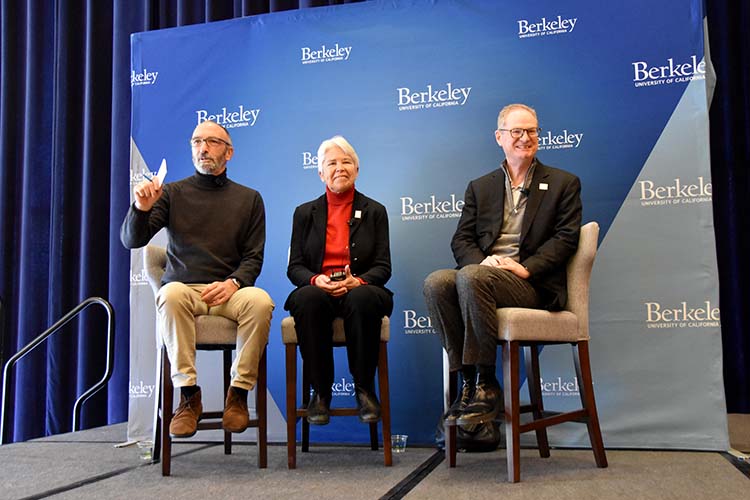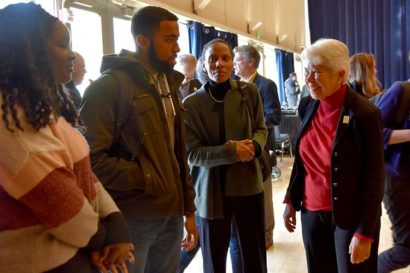How can UC Berkeley become more diverse?
Top two campus leaders weigh in during semester's final Campus Conversation
December 12, 2018
UC Berkeley’s top two leaders presented the case Wednesday that the campus can dramatically increase diversity among students, faculty and staff.
Chancellor Carol Christ and her number two administrator, Executive Vice Chancellor and Provost Paul Alivisatos, spoke at the semester’s final Campus Conversation, a speaker series designed to let faculty, staff and students engage with campus leaders.
More ‘Campus Conversations’
Watch recordings of other conversations you might have missed
The pair faced an array of tough questions from the audience assembled in West Pauley Ballroom in the Martin Luther King. Jr. student union — questions about building names, campus climate, recruitment and retention of minority students, staff and faculty as well as the leaders’ commitment to diversity.
Christ, who took over as chancellor in July 2017, was emphatic that diversity is a high priority for her administration.
“Berkeley used to lead the system in diversity in the ‘90s, and now it trails the system,” Christ said. “That, to me, is unacceptable.”
Key to efforts to reverse that trend are a just-announced project to increase diversity in the undergraduate student body and Berkeley’s new 10-year strategic plan, which calls for enrolling a student body that is at least a quarter Latinx by 2028.
Concrete plans to increase diversity of faculty and staff will be announced early in 2019, Christ said.

Dan Mogulof, left, assistant vice chancellor for public affairs, interviewed Chancellor Carol Christ and Executive Vice Chancellor and Provost Paul Alivisatos. (UC Berkeley photos by Hulda Nelson)
For undergraduates, Christ presented three areas of focus.
UC Berkeley, she said, needs to do a better job communicating with underrepresented high school students and encouraging them to apply. The campus must also ensure the race-blind admissions process doesn’t inadvertently discriminate against minority applications and must create a welcoming campus climate, she said.
“One of the most powerful learning experiences of the last year (for me) was to realize the extent to which we do not have on this campus what we call ‘equity of experience,’” Christ said. “There are dramatically different levels of resources available to students on this campus.”
Christ pointed to the 10 percent of undergraduates who don’t have access to stable housing or can’t afford food. UC Berkeley’s administration offers support for students in need, but many don’t know how to find or access help, she said.
“If you don’t know where you are going to sleep at night and you don’t have enough food to eat, you are not able to do your best at your academics,” Christ said. “This campus is a complex campus that is very difficult to navigate, that is easier for some students than it is for others.”

Christ, right, talks with ASUC Senator and third-year student Amir Wright, second from left, after the event.
Efforts are already underway to increase faculty diversity, another important way to help students from underrepresented groups feel welcome on campus, Alivisatos said.
“Students want to see themselves in the faculty,” he said.
One plan is to hire five new groups of faculty — experts in areas like Native American studies, incarceration or immigration — across Berkeley’s colleges and units.
The idea, Alivisatos said, is that a cohort of newly hired immigration experts from data science, law, education or political science could work together to research issues.
“In general, these areas of inquiry or discovery will be bringing groups of faculty together, and by defining those subjects in a cross-cutting way we really think we’ll be able to alter the faculty diversity and really help the campus to be ready to address … inequality or the future of democracy,” he said.
Hiring new, younger faculty is also an important part of the plan, he said. Donors have contributed enough to grow the faculty by eight this year, he said.
It is tempting to dismiss issues of diversity or equity as impossible to solve, or beyond the scope of a public school like UC Berkeley, but that’s the wrong response, Christ said.
“It is easy to say ‘Oh, it is Prop. 209 — you can’t do anything,’” she said, referring to a state law that prevents UC Berkeley from considering race during the admissions or hiring process.

Mogulof, left, relayed the audience questions about diversity during the event.
“But that is not getting in the way of UCLA, that is not getting in the way of UC Davis,” she added, pointing to two campuses that are more diverse than Berkeley. “The fact that we are lagging seems to suggest there are different things we can do that will increase our diversity.”
Christ also called on the campus community to hold her and her fellow administrators accountable as they attempt to put the plans into action.
“The big challenge is always implementation,” Christ said. “I think we have to have the will to stick the course, to keep our focus and to make sure our talk turns into real differences into initiatives and programs.”
Campus Conversations will resume next semester. For more details visit campusconversations.berkeley.edu.
Contact Will Kane at [email protected]